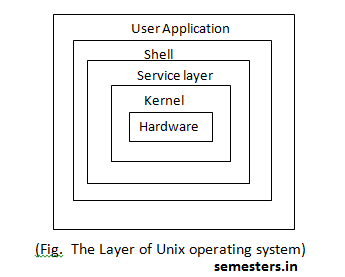UNIX Architecture:
UNIX is multi user, multi-tasking operating system. UNIX has a hierarchical architecture consisting of several layers provides a unique function as well as maintains interaction with its lower layers. Such hierarchal or modular architecture is advantageous for the operating system as failure of one layer does not disrupt the functioning of the whole OS. The layers of the Unix OS are:
- Kernel
- Service
- Shell
- User application
Kernel: Kernel is the core of the Unix OS and it gets loaded in to memory whenever switch on the computer. The kernel contains three components which are:
Scheduler: it schedules the processing of various jobs
Device Driver: it helps in controlling the I/O devices attached to the computer.
I/O Buffer: it controls the I/O operations in the computer.
The kernel enables a user to access the hardware with the help of system calls, where a system calls is a service request that is passes to the kernel for the executing a user program.
Functions perform by the kernel:
- Initiating & executing different program at the same time.
- Allocating memory to the various user and system processes.
- Monitoring the files that reside on the disk.
- Sending & receiving information to and from the network.
Service: In the service layer, request is received from the shell and they are then transformed into command to the kernel.
Services include:
- Providing access to various input and output devices such as keyboard and monitor.
- Providing access to storage device, such as disk drives.
- Controlling different file manipulation activities such as reading from a file & writing to a file.
Shell: The third layer in the UNIX architecture is the shell which acts as an interface between a user and the computer for accepting the request and executing programs.
“Shell is the command line interpreter. User interacts with system through shell.”
UNIX has following most popular shell:
Shell Command Prompt
Bourne shell $
C shell %
Korn shell $
Bash shell #
User Application: The last layer in the UNIX architecture is the user application, which is used to perform several tasks and communicating with other user of UNIX.

E.g.- text processing, software development, database management , & electronic communication.
General purpose commands of UNIX OS:
cal: display the calendar
Syntax: $cal [month][year]
date: display the system date and time.
Syntax: $date
who: display the list of users currently logged in
Syntax: $ who
ls: display the list of files/directories.
Syntax: $ ls [-option]
Some options are: -c (list entries by columns)
-r (list subdirectory too)
cp: copy one file to another
Syntax: $ cp filename1 filename2
mv: move one file to another
Syntax: $ mv filename1 filename2
cat: display the content of file.
Syntax: $ cat filename
mkdir: create a new directory/subdirectory.
Syntax: $mkdir dirname
rm: remove a file/directory.
Syntax: $rm filename
rmdir: remove or delete directories & subdirectories
Syntax: $rmdir dirname
who am i: give the login details.
Syntax: $who am i
